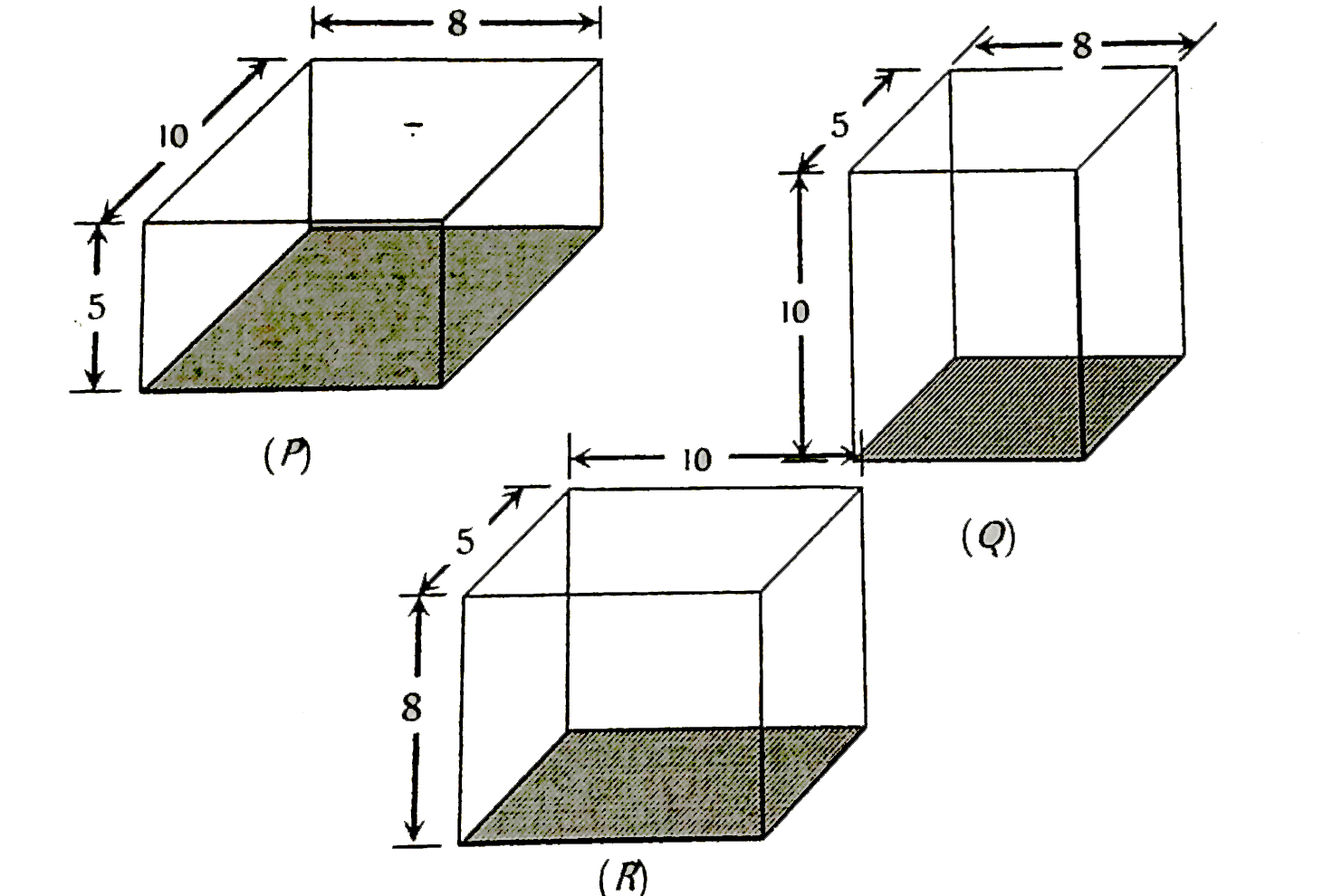An iron block of sides 5cm×8cm×15cm has to be pushed along the floor. The force required will be minimum when the surface in contact with ground is
8cm×15cm surface
8cm×5cm surface
5cm×15cm surface
force is the same for all surfaces
To determine the minimum force required to push an iron block of dimensions 5 cm x 8 cm x 15 cm along the floor, we need to analyze the relationship between the surface area in contact with the ground and the frictional force acting on the block.
1. Understanding the Block Dimensions:
The block has three dimensions: 5 cm, 8 cm, and 15 cm. We can denote these dimensions as:
- Length (L) = 15 cm
- Width (W) = 8 cm
- Height (H) = 5 cm
2. Identifying the Contact Surface:
The block can be placed on any of its three faces:
- Face 1: 5 cm x 8 cm
- Face 2: 5 cm x 15 cm
- Face 3: 8 cm x 15 cm
3. Calculating the Area of Each Face:
- Area of Face 1 (5 cm x 8 cm) = 40 cm²
- Area of Face 2 (5 cm x 15 cm) = 75 cm²
- Area of Face 3 (8 cm x 15 cm) = 120 cm²
4. Understanding Frictional Force:
The frictional force (f) that opposes the motion is given by:
f=μs⋅N
where:
- μs = coefficient of static friction
- N = normal force (equal to the weight of the block when on a horizontal surface)
5. Normal Force Calculation:
The normal force N is independent of the area of contact and is equal to the weight of the block:
N=m⋅g
where m is the mass of the block and g is the acceleration due to gravity.
6. Frictional Force Independence:
Since the frictional force depends only on the normal force and the coefficient of friction, and not on the area of contact, the frictional force will be the same regardless of which face is in contact with the ground.
7. Conclusion:
The minimum force required to push the block will be the same for all surfaces in contact with the ground. Therefore, the force required will be minimum when the surface in contact with the ground is any of the three faces.
Final Answer:
The force required will be minimum when the surface in contact with the ground is any of the three faces (5 cm x 8 cm, 5 cm x 15 cm, or 8 cm x 15 cm).
---
The block has three dimensions: 5 cm, 8 cm, and 15 cm. We can denote these dimensions as:
- Length (L) = 15 cm
- Width (W) = 8 cm
- Height (H) = 5 cm
The block can be placed on any of its three faces:
- Face 1: 5 cm x 8 cm
- Face 2: 5 cm x 15 cm
- Face 3: 8 cm x 15 cm
- Area of Face 1 (5 cm x 8 cm) = 40 cm²
- Area of Face 2 (5 cm x 15 cm) = 75 cm²
- Area of Face 3 (8 cm x 15 cm) = 120 cm²
The frictional force (f) that opposes the motion is given by:
f=μs⋅N
where:
- μs = coefficient of static friction
- N = normal force (equal to the weight of the block when on a horizontal surface)
The normal force N is independent of the area of contact and is equal to the weight of the block:
N=m⋅g
where m is the mass of the block and g is the acceleration due to gravity.
Since the frictional force depends only on the normal force and the coefficient of friction, and not on the area of contact, the frictional force will be the same regardless of which face is in contact with the ground.
The minimum force required to push the block will be the same for all surfaces in contact with the ground. Therefore, the force required will be minimum when the surface in contact with the ground is any of the three faces.
The force required will be minimum when the surface in contact with the ground is any of the three faces (5 cm x 8 cm, 5 cm x 15 cm, or 8 cm x 15 cm).
Topper's Solved these Questions
Similar Questions
Knowledge Check
An iron block of sides 50cm×8cm×15cm has to be pushed along the floor. The force required will be minimum when the surface in contact with ground is
 A8cm×15cm surfaceB50cm×15cm surfaceC8cm×50cm surfaceDforce is same for all surface
A8cm×15cm surfaceB50cm×15cm surfaceC8cm×50cm surfaceDforce is same for all surfaceA block of steel of size 5cm×5cm×5 cm is weighed in water. If the relative density of steel is
A6×5×5×5gB4×4×4×7gC5×5×5×7gD4×4×4×6gIn the given figure from a cuboidal solid metallic block of dimensions 15cm×10cm×5cm a cylindrical hole of diamter 7 cm is drilled out . Find the suface area of the remaining block .
 A450cm2B553cm2C550cm2D583cm2
A450cm2B553cm2C550cm2D583cm2
A rectangular block is 5 cm xx 5 cm xx 10 cm in size. The block floating in water change will occur in the level of water ?
View SolutionA block of steel of size 5cm×5cm×5cm is weighed in water. If the relative density of steel is 7. its apparent weight is:
View SolutionA cuboid (3cm×4cm×5cm) is cut into unit cubes. The ratio of the total surface area of all the unit cubes to that of the cuboid is
View SolutionA metal box measures 20cm×12cm×5cm. Thickness of the metal is 1 cm. Find the volume of the metal required to make the box.
View SolutionA rectangular block of size 10cm×8cm×5cm is kept in three different positions P,Q and R in turns as shown in the figure. In each case, the shaded area is rigidly fixed and a definite force F is applied tangentially to the opposite face to deform the black. The displacement of the upper face will be

View Solution
